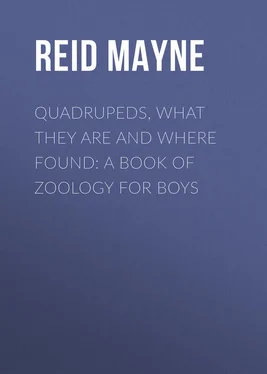Mayne Reid - Quadrupeds, What They Are and Where Found - A Book of Zoology for Boys
Здесь есть возможность читать онлайн «Mayne Reid - Quadrupeds, What They Are and Where Found - A Book of Zoology for Boys» — ознакомительный отрывок электронной книги совершенно бесплатно, а после прочтения отрывка купить полную версию. В некоторых случаях можно слушать аудио, скачать через торрент в формате fb2 и присутствует краткое содержание. Жанр: literature_19, foreign_antique, foreign_prose, на английском языке. Описание произведения, (предисловие) а так же отзывы посетителей доступны на портале библиотеки ЛибКат.
- Название:Quadrupeds, What They Are and Where Found: A Book of Zoology for Boys
- Автор:
- Жанр:
- Год:неизвестен
- ISBN:нет данных
- Рейтинг книги:5 / 5. Голосов: 1
-
Избранное:Добавить в избранное
- Отзывы:
-
Ваша оценка:
- 100
- 1
- 2
- 3
- 4
- 5
Quadrupeds, What They Are and Where Found: A Book of Zoology for Boys: краткое содержание, описание и аннотация
Предлагаем к чтению аннотацию, описание, краткое содержание или предисловие (зависит от того, что написал сам автор книги «Quadrupeds, What They Are and Where Found: A Book of Zoology for Boys»). Если вы не нашли необходимую информацию о книге — напишите в комментариях, мы постараемся отыскать её.
Quadrupeds, What They Are and Where Found: A Book of Zoology for Boys — читать онлайн ознакомительный отрывок
Ниже представлен текст книги, разбитый по страницам. Система сохранения места последней прочитанной страницы, позволяет с удобством читать онлайн бесплатно книгу «Quadrupeds, What They Are and Where Found: A Book of Zoology for Boys», без необходимости каждый раз заново искать на чём Вы остановились. Поставьте закладку, и сможете в любой момент перейти на страницу, на которой закончили чтение.
Интервал:
Закладка:
Mayne Reid
Quadrupeds, What They Are and Where Found: A Book of Zoology for Boys
Preface
I have been called upon to write illustrative sketches to a series of engravings, designed by an eminent artist. In performing my part of the work I have thrown the Mammalia into twenty-four groups – corresponding more or less to the picture designs – and have dwelt chiefly on the geographical distribution of the animals. The Cetaceae and Vespertilionidae are properly omitted.
In the groups given there is no attempt made at any very scientific arrangement. The sketches are purely of a popular character, even the scientific nomenclature being avoided. It is hoped, however, that they may prove of service to the zoological tyro, and form as it were his first stepping-stone to a higher order of classification.
In reality, notwithstanding the prodigious speculations of learned anatomists, no truly good arrangement of the Mammalia has yet been arrived at; the deficiency arising from the fact that, as yet, no true zoologist has had the opportunity of a sufficiently extended observation of the natural habits of animals.
Now, however, that the great agent – steam – has as it were “brought the ends of the earth together,” the opportunity is no longer wanting; and it is to be hoped that a better classification may soon be obtained. Who knows but that some ardent young zoologist, who has taken his first lessons from this little book, may be the man to supply the desideratum? Who knows?
Such a result would be a proud triumph for the author of these monographic sketches.
Mayne Reid.
Chapter One.
Monkeys of the Old World
The great family of the Monkeys, or the “Monkey tribe,” as it is usually called, is divided by naturalists into two large groups – the “Monkeys of the Old World,” or those that inhabit Africa, Asia, and the Asiatic islands; and the “Monkeys of the New World,” or those that belong to America. This classification is neither scientific nor natural, but as it serves to simplify the study of these quadrupeds – or quadrumana , as they are termed – it is here retained. Moreover, as there is no genus of monkey, nor even a species, common to both hemispheres, such a division can do no harm.
The number of species of these animals, both in the Old and New Worlds, is so great, that to give a particular description of each would fill a large volume. It will be only possible in this sketch to point out the countries they inhabit, and to say a word or two of the more remarkable kinds.
In point of precedence, the great Ourang-outang contests the palm with the Chimpanzee . Both these creatures often attain the size of an ordinary man, and individuals of both have been captured exceeding this size; while, at the same time, in muscular strength, one of them is supposed to equal seven or eight men. It is remarkable how little is known of the habits of either. This is accounted for by the fact that they both inhabit regions still unexplored by civilised man, dwelling in thick impenetrable forests, where even the savage himself rarely penetrates.
Although many exaggerated stories are told of these great satyr apes, and many of these are only “sailors’ yarns,” yet it is easy to believe that animals approaching in structure, and even in intelligence, to man himself, must possess habits of the most singular kind. There is little more known of them than there was hundreds of years ago – indeed, we might say thousands of years; for it is evident that the Carthaginians came into contact with the chimpanzee on the western coast of Africa, and through them the Romans became acquainted with it; and no doubt it was this animal that gave origin to most of their stories of satyrs and wild men of the woods.
The chimpanzee is found only in the forests of tropical Africa – more especially along the west coast, the banks of the Gaboon, and other rivers. The ourang-outang is exclusively Asiatic – inhabiting Borneo, Sumatra, the peninsula of Malacca, Cochin China, and several others of the large Oriental islands. Of the ourang-outang there are two species – perhaps three – differing very little, except in point of size and colour.
A group of large tail-less apes, usually denominated Gibbons , or Long-armed Apes, come next in order. These are neither so large nor human-like as the ourang or the chimpanzee; nevertheless, they are capable of walking upon their hind legs, after the manner of bipeds. They are all long-armed apes, and generally use their fore-arms in walking, but more to assist them in clinging to the branches of trees, and swinging themselves from one to the other.
The gibbons are all Asiatic monkeys, and inhabit the same countries with the ourang, viz., the tropical forests of India and the Indian Archipelago. There are at least a dozen species of them, nearly half of which are found in the Island of Sumatra alone.
The Proboscis monkeys follow the gibbons. These are also long-armed apes, but with tails and sharp proboscis-like snouts, from which their name is derived. Only two species are known – both belonging to the great Island of Borneo, so rich in varieties of these human-like mammalia. One of the species of proboscis monkeys has also been observed in Cochin China. Another large tribe of Asiatic apes, containing in all nearly twenty different species, has been constituted into a genus called Semnopithecus . These also inhabit the Indian continent and the great islands; but they are not so exclusively tropical in their habits, since several of the species extend their range northward to Nepaul, and other districts among the Himalaya Mountains. It is a species, or more than one, of these ugly apes that is venerated by the Hindus; and they are permitted to live without molestation in the sacred groves and temples, though they often prove most troublesome protegées to their fanatical benefactors.
In Africa, the representatives of this last-mentioned tribe are found in the Colobus monkeys. Of these there are about a dozen species; and from several of them are obtained the long-haired monkey skins of commerce. They are all tropical animals, and inhabit the middle zone of Africa – their range extending from Abyssinia to the shores of the Atlantic.
Another very large tribe, containing in all as many as thirty species, and belonging exclusively to Africa, are the Guenons . They are closely allied to the colobus monkeys, but yet sufficiently different from them in habits and conformation to be classed into a separate genus. Most of the guenons inhabit the central regions of Africa; but they are not exclusively tropical, since several kinds belong to Kaffraria, and that region indefinitely called the Cape of Good Hope.
The Macaco apes constitute another genus, which forms the link between the guenons and the baboons, or dog-headed monkeys. They are neither exclusively African nor Asiatic monkeys, since species of macacoes are found in both these continents. They are usually subdivided into the macacoes with long tails, and those with short tails; and there is one species which wants this appendage altogether. This is the Magot – perhaps the most noted of all the macacoes, since it was the earliest known to European nations, and is, in fact, the only species that is indigenous to Europe. It is the magot that inhabits the Rock of Gibraltar. Much has been written as to whether this monkey is really indigenous to Europe – some naturalists alleging that it reached Gibraltar from Africa, where it is also common. But it is not generally known that, on European ground, the magot is not confined solely to the Gibraltar Rock. It is also found in other parts of the south of Spain; and, it is likely enough, has existed there long enough to claim the character of a native.
Читать дальшеИнтервал:
Закладка:
Похожие книги на «Quadrupeds, What They Are and Where Found: A Book of Zoology for Boys»
Представляем Вашему вниманию похожие книги на «Quadrupeds, What They Are and Where Found: A Book of Zoology for Boys» списком для выбора. Мы отобрали схожую по названию и смыслу литературу в надежде предоставить читателям больше вариантов отыскать новые, интересные, ещё непрочитанные произведения.
Обсуждение, отзывы о книге «Quadrupeds, What They Are and Where Found: A Book of Zoology for Boys» и просто собственные мнения читателей. Оставьте ваши комментарии, напишите, что Вы думаете о произведении, его смысле или главных героях. Укажите что конкретно понравилось, а что нет, и почему Вы так считаете.












